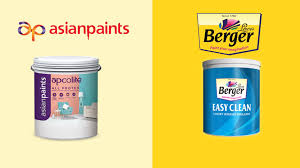Add your promotional text...
Asian Paints vs. Berger Paints: Unveiling the Titans of India's Paint Industry
Synopsis: The Indian paint industry is witnessing remarkable growth, driven by rapid urbanization, rising disposable incomes, and government initiatives. This comprehensive analysis delves into the competitive landscape between Asian Paints and Berger Paints, examining their market positions, revenue growth, profitability, and future prospects. While Asian Paints has established itself as the market leader with superior financial performance and strategic market expansion, Berger Paints remains a formidable contender. Investors are advised to consider both companies' growth potential and risk factors in this evolving industry.
ANALYSIS AND OPINION
By Vikash Purohit
8/16/20244 min read


The Indian paint industry is thriving, bolstered by a range of positive factors. Rapid urbanization and a growing middle class are driving demand for both residential and commercial spaces, which in turn fuels the need for paints and coatings. Government initiatives like the Pradhan Mantri Awas Yojana and increased investments in infrastructure, such as roads and airports, are also contributing to this growth. While architectural coatings are experiencing substantial growth, other sectors like automotive and industrial coatings are also on the rise, reflecting a broader recovery from the pandemic and increased industrial activity.
Market Leaders: Asian Paints and Berger Paints
Among the leading companies in this sector are Asian Paints and Berger Paints, both instrumental in shaping the industry's trajectory. Their strategic investments in product development, distribution networks, and research and development have allowed them to capitalize on the industry's growth. With their strong brand equity and financial resilience, these companies are positioned to maintain their market leadership.
Asian Paints, the largest paint company in India, has a dominant market presence, while Berger Paints is the second-largest, holding a 19.7% market share in FY24. Both companies focus primarily on decorative paints, although their market approaches and product offerings differ significantly.
Business Overview and Product Offerings
Asian Paints leads in the decorative segment, contributing over 88% of its total revenue, with the remaining 12% coming from international and industrial segments. Berger Paints, in contrast, generates 80% of its revenue from decorative paints and 20% from industrial paints. Asian Paints has expanded into the home décor business, offering a broader range of products compared to Berger Paints.
Manufacturing capabilities also differ; Asian Paints operates 27 facilities globally and is present in 14 countries, whereas Berger Paints has 29 facilities and operates in only three countries outside India.
Revenue Growth and Financial Performance
Revenue growth is a crucial metric for assessing market dominance. Asian Paints has experienced a compound annual growth rate (CAGR) of 13.2% over the last five years, surpassing Berger Paints’ 12.9% CAGR. This growth is notable considering Asian Paints is significantly larger in revenue size.
In the decorative paints segment, Asian Paints has achieved balanced growth across urban and rural areas, with the economy and luxury segments performing notably well. Conversely, Berger Paints has shown resilience despite inflationary pressures and a prolonged monsoon, with strong volume growth in the economy segment and solid results in protective coatings and automotive paints.
Profitability and Margins
Profitability is a key area where Asian Paints outperforms Berger Paints. Asian Paints has a higher five-year average operating margin of 18%, compared to Berger Paints’ 14.2%. This superior cost management, combined with a larger presence in higher-margin decorative paints, contributes to Asian Paints' better profitability. Asian Paints also leads in net profit growth with a CAGR of 20.3%, compared to Berger Paints’ 18.8%.
In terms of net margin, Asian Paints maintains an average of 11.3%, while Berger Paints stands at 8.3%. Both companies have benefited from deflating raw material prices, improving their margins in recent years.
Distribution Network and Returns
The dealer network is critical in the paint industry. Asian Paints has over 70,000 dealers, while Berger Paints has around 25,000. This extensive network supports their market reach and growth.
Return on capital employed (RoCE) and return on equity (RoE) are vital indicators of profitability and efficiency. Asian Paints has a five-year average RoE of 28% and RoCE of 36.5%, surpassing Berger Paints’ 23.3% RoE and 28.7% RoCE. These figures indicate that Asian Paints is generating higher returns for its shareholders compared to Berger Paints.
Dividends and Valuations
Shareholder returns in the form of dividends are another important consideration. Asian Paints has provided an average dividend of Rs 13.6 over the last five years, compared to Berger Paints' Rs 2.3. The five-year average dividend yield for Asian Paints is 0.8%, higher than Berger Paints' 0.5%.
Valuation ratios such as price-to-earnings (P/E) and price-to-book value (P/BV) help assess whether a company's shares are overvalued or undervalued. Asian Paints' P/E ratio is 57.2, and P/BV ratio is 15.5, while Berger Paints' ratios stand at 54.7 and 11.9, respectively. Both companies’ ratios are below their five-year medians, indicating that the stocks are currently undervalued.
Future Prospects and Industry Trends
The Indian paints and coatings market is expected to reach USD 9.56 billion in 2024, with projections to grow to USD 15 billion by 2029, reflecting a CAGR of 9.38%. Despite this growth, paint consumption in India remains below global averages, signaling a substantial untapped market, especially in smaller cities.
The ongoing momentum in construction, coupled with increasing urbanization and disposable incomes, is expected to drive future demand. Companies like Asian Paints and Berger Paints are diversifying their offerings beyond traditional paints into home solutions, including interior design and décor products, to capture a larger share of the expanding market.
However, increased competition from new entrants like Grasim Industries and the evolving market dynamics pose challenges. The industry is likely to undergo consolidation, with established players like Asian Paints and Berger Paints having the advantage due to their strong distribution networks and financial stability.
Conclusion: Asian Paints vs Berger Paints
Asian Paints has emerged as the clear market leader, surpassing Berger Paints in revenue growth, profitability, and shareholder returns. Its deep understanding of consumer behavior and efficient supply chain have been pivotal to its success. Berger Paints, while resilient, faces challenges in closing the gap with Asian Paints.
Investors should carefully evaluate both companies’ valuations, growth prospects, and risk profiles before making investment decisions. With their established market positions, both companies are likely to remain significant players in the Indian paint industry, well-positioned to navigate future challenges and capitalize on emerging opportunities.
